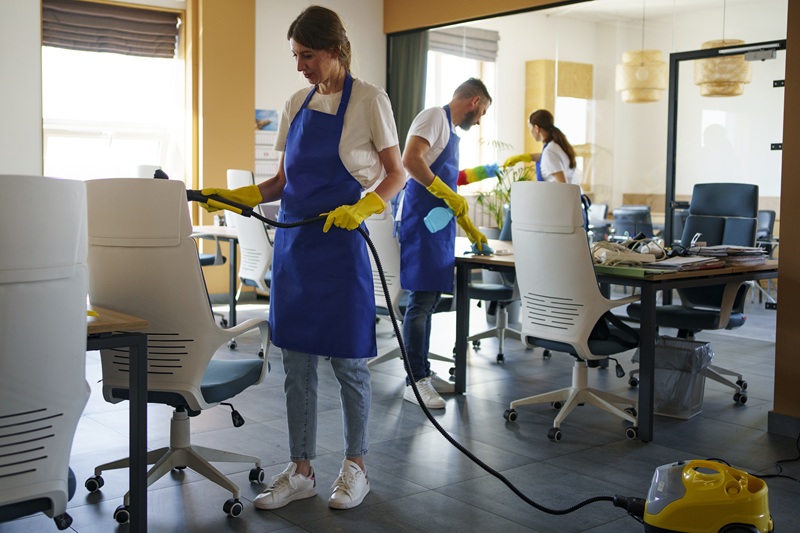The Office Cleaning Checklist Every Workplace Needs

Maintaining a clean and tidy office isn’t just about aesthetics—it’s about creating a healthier, more productive environment for employees and visitors. A clutter-free, sanitized workplace boosts morale, promotes focus, and reduces the spread of germs. Whether you’re responsible for office cleaning or managing a team of professionals, having a comprehensive cleaning checklist ensures that nothing is overlooked. Here’s a must-have office cleaning checklist for every workplace.
1. Daily Tasks
Desks and Workstations:
Each desk should be wiped down daily, especially the frequently-touched areas like keyboards, phones, and light switches. Encourage employees to clear their desks at the end of the day to make cleaning easier and more thorough. If your office has unique cleaning needs, consider office cleaning tailored to your business to ensure a customized approach that addresses specific challenges.
Trash and Recycling:
Emptying trash cans and recycling bins should be a daily task. Leftover food, paper, and office supplies can quickly build up, leading to unpleasant odors and clutter. Consider placing additional bins for paper recycling near workstations to make disposal easier.
Kitchen and Break Area:
The kitchen area is often a hotspot for spills and messes. Wipe down countertops, clean the microwave and refrigerator, and ensure that dishes are properly washed or loaded into the dishwasher. Don’t forget to sanitize door handles and faucets, as these are commonly touched by multiple people throughout the day.
High-Touch Surfaces:
Common areas like doorknobs, light switches, elevator buttons, and stair rails are high-touch zones that should be sanitized daily. These areas can quickly become breeding grounds for germs, so make sure they’re cleaned with disinfectant regularly.
Restrooms:
The bathroom is one of the most important areas to keep clean, as it directly impacts the health of your staff. Daily tasks should include scrubbing toilets, sinks, and countertops, restocking soap and paper products, and sanitizing door handles, faucets, and light switches. This ensures a fresh and hygienic restroom environment throughout the day.
2. Weekly Tasks
Floors:
Vacuuming carpets and sweeping or mopping hard floors should be done at least once a week to maintain a clean environment. In high-traffic areas, consider spot cleaning as needed to prevent the buildup of dirt and grime.
Dusting:
Dusting surfaces such as desks, shelves, and windowsills should be done weekly. Don’t forget about vents, light fixtures, and ceiling fans, which can accumulate dust over time. A clean, dust-free environment is crucial for preventing allergies and ensuring that the air quality remains healthy.
3. Monthly Tasks
Deep Clean Carpets and Upholstery:
While weekly vacuuming is essential, it’s important to deep clean carpets and upholstery once a month. This will help remove embedded dirt, stains, and allergens that regular cleaning may miss. Consider hiring a professional cleaning service for this task to ensure a thorough job.
Windows and Blinds:
Windows can accumulate dust and smudges, while blinds trap dust and allergens. Cleaning both inside and outside windows (when possible) and wiping down blinds ensures a clear, fresh appearance. If your office is located in a multi-story building, consider hiring professional window washers for safety.
Office Equipment:
Take time to disinfect office equipment like phones, copiers, and printers, as these are frequently touched by multiple employees. Don’t forget computer monitors and keyboards—they’re breeding grounds for germs, especially if several people share the same equipment.
4. Quarterly Tasks
Deep Clean Kitchens and Break Areas:
Every few months, take the time to deep clean the kitchen, including organizing the refrigerator, removing expired food, and wiping down the inside of cabinets and drawers. A thorough cleaning will keep your break area hygienic and free of unpleasant odors.
Air Vents and Ducts:
Clean air vents, ducts, and air conditioning units to improve airflow and maintain good indoor air quality. Dust and allergens can accumulate in these areas, leading to poor air quality and potential health issues for employees.
Having a clear, structured office cleaning checklist ensures that your workplace remains clean, organized, and healthy. Regular cleaning not only creates a pleasant environment for employees but also helps prevent the spread of germs, reduces stress, and improves overall productivity. |